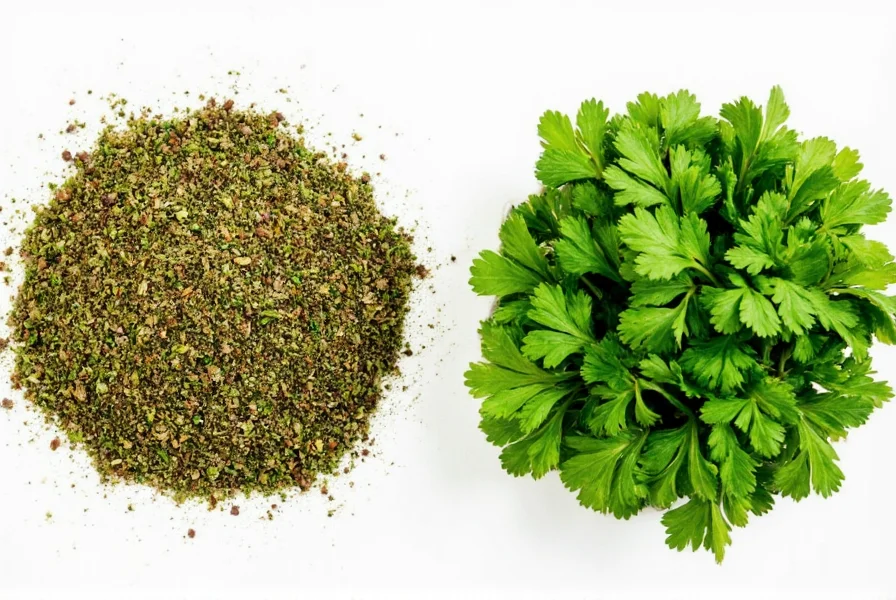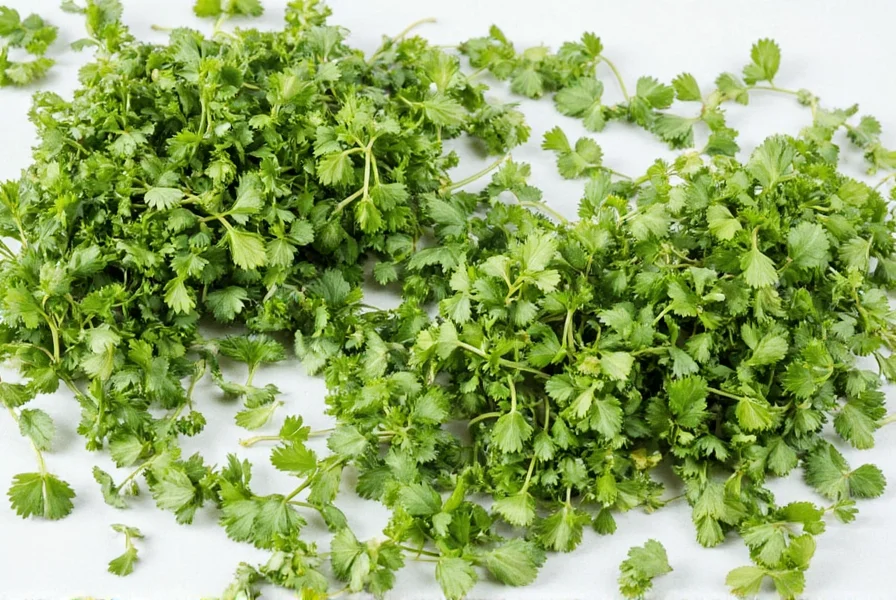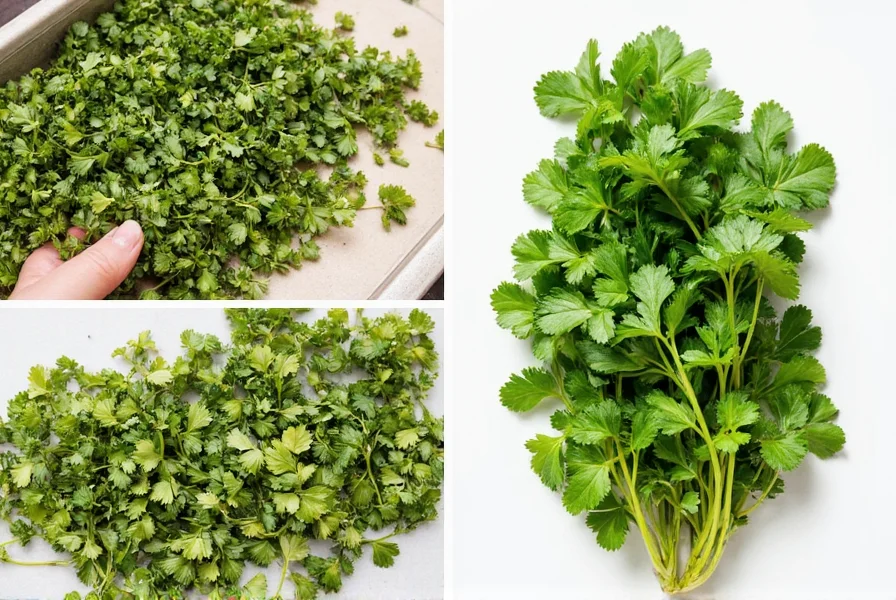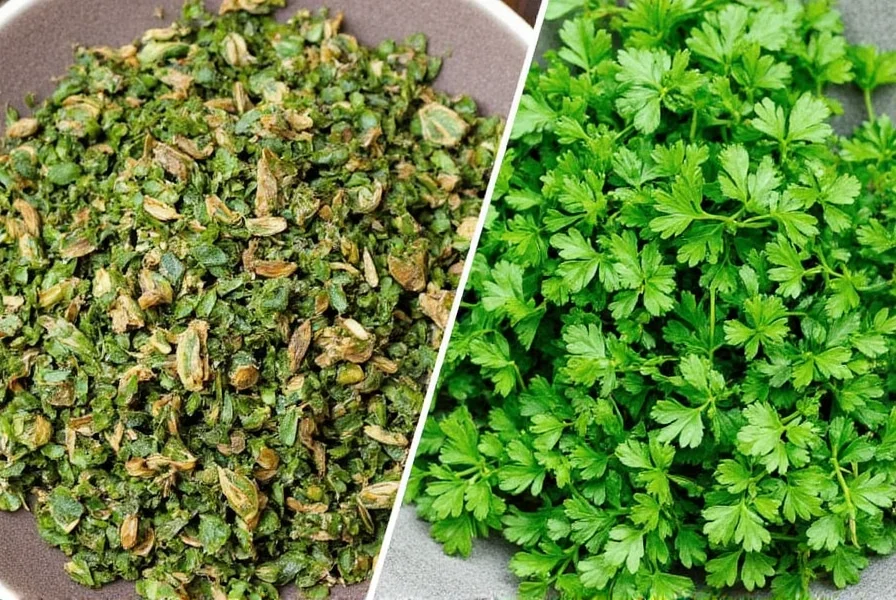Table of Contents
Dried vs Fresh Parsley: Key Differences Explained
Dried and fresh parsley differ significantly in flavor, nutritional value, shelf life, and culinary applications. Here's a precise comparison of their core characteristics:
| Aspect | Dried Parsley | Fresh Parsley |
|---|---|---|
| Aroma | Mild, muted | Herbaceous, bright |
| Flavor | Subtle, slightly earthy | Zesty, grassy, peppery |
| Shelf Life | 6–12 months | 7–10 days (refrigerated) |
| Nutritional Value | Moderate vitamin K, C | High in vitamins A, C, K |
| Use Case | Cooked dishes, soups, stews | Garnish, salsas, sauces, salads |
When to Use Dried vs Fresh Parsley
Understanding the right application for each type maximizes flavor impact:
- Dried parsley works best in long-cooked dishes where its concentrated flavor integrates fully: meatloaf, tomato sauces, braises, and spice blends.
- Fresh parsley should be added at the end of cooking or used raw: tabbouleh, chimichurri, pasta dishes, roasted vegetables, and as a vibrant garnish.

Conversion Ratio Guide
The standard conversion ratio is 1:3 (1 teaspoon dried = 1 tablespoon fresh). This is because drying removes water content, concentrating flavors. When substituting:
- For dried-to-fresh: Triple the amount of fresh parsley
- For fresh-to-dried: Use one-third the amount of dried parsley
Important timing notes:
- Add dried parsley early in cooking (30+ minutes) to rehydrate and release flavor
- Add fresh parsley in the last 5-10 minutes or as a garnish to preserve brightness
Storage Secrets for Maximum Freshness
Proper storage extends freshness by 2-3x:
Refrigerator Jar Method
Place stems in a jar with 1 inch of water. Cover loosely with plastic bag. Store upright in fridge. Refresh water every 2 days. Lasts up to 14 days.

Freezing Options
Ice Cube Method: Chop parsley, mix with water or olive oil, freeze in ice cube trays. Use directly in soups and sauces.
Whole Bunch Method: Wash, dry thoroughly, wrap in paper towels, place in freezer bag. Crush needed amount straight from freezer.

Buying Guide: Top Dried & Fresh Parsley Picks
Fresh Parsley Selection Tips
- Look for vibrant green leaves with no yellowing or browning
- Stems should be crisp and moist, not slimy or dry
- Avoid pre-chopped options - whole bunches retain flavor longer
| Product | Features | Best For | Price Range |
|---|---|---|---|
| Fresh Origins Italian Parsley | Pre-washed, resealable packaging, organic option | Quick prep, urban kitchens | $1.99–$2.99 |
| Trader Joe's Organic Flat Leaf | Locally sourced, eco-friendly packaging | Eco-conscious cooks, Mediterranean recipes | $1.49–$1.99 |
| Farmer's Market Local Bunch | Freshest option, supports local growers | Weekend cooking, large batches | $2.00–$3.50 |
Dried Parsley Selection Tips
- Check expiration dates - opt for recent packaging
- Color should be deep green (not faded or gray)
- Smell test: must have strong herbal aroma
- Choose glass jars over plastic for better preservation
| Product | Features | Best For | Price Range |
|---|---|---|---|
| McCormick Culinary Dried Parsley | Restaurant-grade quality, long shelf life | Baking, simmered dishes | $4.00–$5.00 |
| Simply Organic Dried Parsley Flakes | USDA Organic, non-GMO | Health-focused cooks, slow cookers | $3.50–$4.50 |
| Great Value Dried Parsley | Budget-friendly, consistent supply | Everyday meals, seasoning blends | $2.00–$2.50 |
Frequently Asked Questions
What's the conversion ratio between dried and fresh parsley?
The standard conversion ratio is 1:3 - meaning 1 teaspoon of dried parsley equals approximately 1 tablespoon of fresh chopped parsley. Dried herbs are more concentrated because the drying process removes water content, intensifying the flavor. When substituting fresh for dried in recipes, you'll need to use about three times the amount of fresh parsley to achieve similar flavor intensity.
Can I substitute fresh parsley for dried in recipes?
Absolutely! Adjust quantities using the 1:3 ratio. Add dried parsley early in cooking to allow flavor development, while fresh parsley should be added in the last 5-10 minutes or as a garnish to preserve its bright flavor and color. For cold dishes like salads or sauces, always use fresh parsley.
Why does fresh parsley taste better than dried?
Fresh parsley contains volatile oils that create its vibrant, grassy flavor and aroma. The drying process causes these delicate compounds to evaporate or break down, resulting in a more muted flavor profile. Fresh parsley also retains higher levels of vitamins A, C, and K compared to dried versions.
How do I adjust cooking times when using fresh vs dried parsley?
Dried parsley needs 30+ minutes of cooking time to rehydrate and release flavor. Fresh parsley should be added in the final 5-10 minutes of cooking or used raw to maintain its color and bright flavor. Never cook fresh parsley for extended periods - it will turn brown and lose flavor.
Is fresh parsley worth the extra cost compared to dried?
Yes. A $2-3 bunch of fresh parsley can elevate multiple meals, while a dried bottle often sits unused for months. Fresh parsley delivers superior flavor and nutrition, and with proper storage (like the jar method), it lasts up to two weeks. The cost per use is significantly lower than dried parsley when used correctly.
Can I dry fresh parsley myself at home?
Yes. Wash and thoroughly dry sprigs, then hang in small bundles in a warm, dark, well-ventilated area for 1-2 weeks. Alternatively, spread leaves on a baking sheet and dry in the oven at 150-170°F for 2-4 hours. Properly dried parsley should crumble easily between your fingers. Store in an airtight container away from light.
What recipes work best with fresh parsley versus dried?
Fresh parsley excels in dishes where its bright flavor shines: tabbouleh, chimichurri, salsa verde, pesto, potato salad, and as a garnish on soups and roasted meats. Dried parsley works better in long-cooked dishes where subtle flavor integrates: meatloaf, tomato sauces, soups, stews, and spice blends. For maximum impact, use fresh parsley as a garnish even on dishes that also contain dried parsley during cooking.











 浙公网安备
33010002000092号
浙公网安备
33010002000092号 浙B2-20120091-4
浙B2-20120091-4